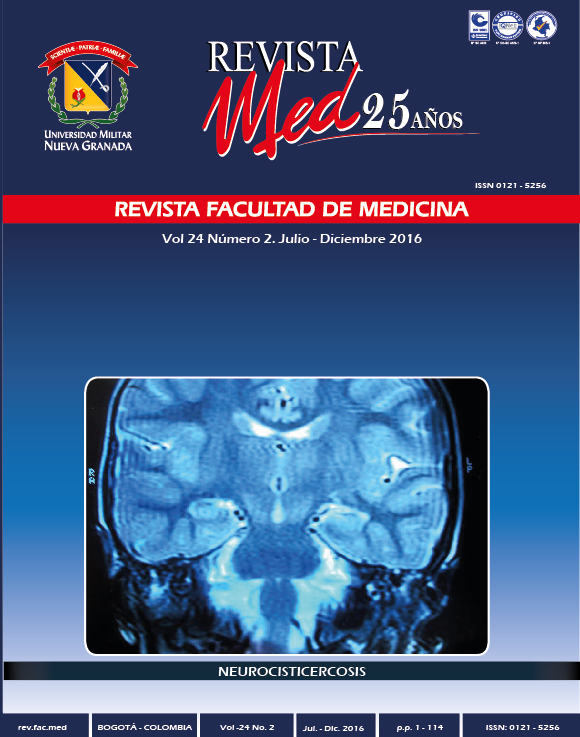Nutritional status and food preferences among university students in Bogotá
Abstract
Introduction: During University life students should strengthen healthy food habits which will contribute to the well-being of the professional adult life. The aim of this study was to assess the nutritional status and the food preferences of a group of undergraduate university students.
Materials and methods: A cross-sectional study was realized. It included students who accepted to participate and completed a single, self-administered food habits questionnaire that asked about their current food practices at the university, general characteristics, anthropometric data, and food organoleptic properties. The data were analyzed with SPSS version 20.
Results: One hundred eighty one students aged 16 – 25 completed the questionnaire. The 83,6% had normal BMI, 7,9% undernourishment, 7,3% overweight and 1,1% obesity. No association between the people with whom the student lives and nutritional status was found (p=0,991). The 17,6% took energy drinks and 41.5% sodas at least once per week. The 37,5% showed to choose junk food at least once per week. Daily intake of dairy foods, fruits and vegetables was observed in less of 20% of the students.
Conclusions: The findings show the importance of establishing early interventions for reaching healthy habits of feeding. These initiatives could be more successful if they include the familiar and social environment and educational institutions.
Downloads
References
Irazusta-Astiazaran A, Hoyos-Cillero I, Díaz-Ere-o E, Irazusta-Astiazaran J, Gil-Goikouria J, Gil-Orozko S. Alimentación de estudiantes universitarios. República Dominicana. Rev Osasunaz 2007;8: 7-18.
Allemand-Jander DI. Clinical diagnosis of metabolic and cardiovascular risks in overweight children: early development of chronic diseases in the obese child. International Journal of Obesity 2010;34:32–36 https://doi.org/10.1038/ijo.2010.237
Requejo A, Ortega R. Nutrición en la adolescencia y juventud. Madrid: Ed. Complutense; 2002. https://books.google.com.co/books?isbn=8474916917 (último acceso 23 de agosto 2016)
Guerra C, Vila J, Apolinaire J, Cabrera A, et al. Factores de riesgo asociados a sobrepeso y obesidad en adolescentes. MediSur 2009; 7(2): 25-34.
Organización Mundial de la Salud. Salud de la madre, el recién nacido, del ni-o y del adolescente. 2016. OMS. http://www.who.int/maternal_child_adolescent/topics/child/development/es/ (ultimo acceso 23 de agosto 2016)
Gallardo-Wong I, Buen Abad-Eslava L. Mala nutrición en estudiantes universitarios de la Escuela de Dietética y Nutrición del ISSSTE. México. Rev Med UV 2011; 11 (1): 6-11.
Vargas-Zárate, Becerra-Bulla F, Prieto-Suárez E. Evaluación de la ingesta dietética en estudiantes universitarios. Bogotá, Colombia. Rev Salud Pública 2010;12 (1):116-125.
Vikrant-Arya, Raneev-Thakur. Organoleptic and Microscopic Analysis of Gentiana regeliana. India. Journal of Pharmacognosy and Phytochemistry 2012;1 (2): 32.
Heymsfield SB, Lohman TG, Wang Z, Going SB. Composición Corporal. 2° ed. México: Mc Graw Hill; 2005. p.521.
Ministerio de Protección Social, Instituto Colombiano de Bienestar Familiar, Instituto Nacional de Salud. Encuesta Nacional de la Situación Nutricional en Colombia 2010 ENSIN. Bogotá: Oficina Asesora de Comunicaciones y Atención al Ciudadano ICBF; 2011. p. 1-509, 6.
Pereira PF, Serrano HM, Carvalho GQ, Lamounier JA, Peluzio MG, Franceschini SC, et al. Body fat location and cardiovascular disease risk factors in overweight female adolescents and eutrophic female adolescents with a high percentage of body fat. Cardiology in the Young 2012; 22: 162–169 https://doi.org/10.1017/S1047951111001430
De Vogli R, Kouvonen A, Gimeno D. La influencia de la desregulación del mercado en el consumo de comida rápida y el índice de masa corporal: un análisis de series temporales entre países. En: Boletín de la Organización Mundial de la Salud. 2014; 92 (2):77-152. Disponible en: www.who.int/bulletin/volumes/92/2/13-120287-ab/es/
Saad C, Ibá-ez E, León C, Colmenares C, Vega N, Díaz Y, et al. Cambios de los hábitos alimentarios de los estudiantes de enfermería de la Universidad El Bosque durante su proceso de formación académica, Bogotá, D.C., 2007. Rev. Colombiana de enfermería 2008; 3: 1909-1621.
Ferro RA, Magui-a VJ. Relación entre hábitos alimentarios e índice de masa corporal en estudiantes de una universidad pública según área de estudio. Lima, 2012, 65 h. Trabajo de grado (Nutrición). Universidad Nacional Mayor De San Marcos. Facultad de Medicina Humana. Disponible en:http://cybertesis.unmsm.edu.pe/bitstream/cybertesis/1123/1/Ferro_mr.pdf
Montero Bravo A., Úbeda Martín N., García González A. Evaluación de los hábitos alimentarios de una población de estudiantes universitarios en relación con sus conocimientos nutricionales. Nutr. Hosp. 2006;21(4): 466-73.
Skuland E,. Healthy Eating and Barriers Related to Social Class. The case of vegetable and fish consumption in Norway. Appetitte 2015; 92: 217-226. https://doi.org/10.1016/j.appet.2015.05.008
Uijl LC., Jager G, Graaf C, Meiselman HL., Kremer S. Emotion, olfaction, and age: A comparison of self-reported food-evoked emotion profiles of younger adults, older normosmic adults, and older hyposmic adults. Food Quality and Preference 2015;48:199–209. https://doi.org/10.1016/j.foodqual.2015.09.011











